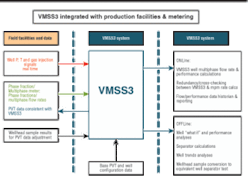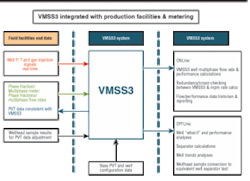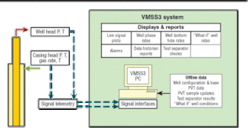Multiphase flow technologies enhance digitalization of oil, gas fields
Bryan T. Yocum, Ensys Yocum Inc.
null
Technologies, designs, and software have developed over the last 50 years that have improved well multiphase flow-rate measurements of oil and gas/condensate wells tremendously. Over the years, the industry engineering standards have considered three-phase separator tests to be the basis for multiphase flow measurements for flowing wells.
After separation, operators normally measure gas flow rates by one-phase orifices or venturi meters designed to ASME standards. Industry standard designs have been used for extensive gas flow rate testing and measurement. The thermodynamic conditions of pressure and temperature levels and the flowing gas densities of the well affect the flow measurements.
Operators use correlations that have been established to correct the gas flow rates to standard rates at 14.73 psig and 60° F, which have the units of standard cf/d. Metric units are also commonly used.
Industry level controllers maintain the liquid phase levels in the test separator by tying to the exit valves in the oil and water exit lines. Field personnel measure the oil and water flow rates by several types of liquid meters: orifice, venturi, positive displacement, coriolis, and less frequently used liquid phase meters.
Field personnel test separators are operated at pressure and temperature levels above atmospheric and 60° F (standard conditions). Oil phase densities vary with reservoir fluid and with the gas in solution (pressure crude). Industry correlations were developed to adjust the liquid flow rates to the standard condition rates measured in barrels per day (b/d).
In the industry’s earlier practice, the water phase was disposed of without measurement. However, it became apparent that water phase disposal into the sea damaged the environment. The government passed laws forcing water disposal into disposal wells or transport of the water phase to shore.
Later, the industry found that the water phase contained enough oil to justify the installation of hydrocyclones and treatment plants to remove residual oil from the water. Operators often installed orifice meters to measure the water phase flow rates.
Testing accuracies
The industry can calibrate single phase meters against standard test meters and meter provers. The calibrating units can be installed on barges and towed to the well platforms to calibrate the test separator meters.
These industry devices provide redundancy to the metered flow rates; however there is uncertainty in all measurements.
The term redundancy refers to measurement of a flow rate twice in different ways. Two measurements made at the same rate provide a check on each other and improve the accuracy of the rate measurement.
Operators show accuracies at field conditions of gas and liquid meters in the +/-2 to 3% range when calibrated. Extensive testing of offshore test separators in the North Sea shows the three-phase flow measurement accuracies in the +/-10 to 13% range. However, the engineering standards of major companies consider flow measurements to be +/-10 %.
Flow regime and rates
In industry’s earlier designs, the internals installed in the test separators to improve the range of flow capacity and improve the accuracy of measurement of the three phases were limited to an inlet impingement plate, a vortex breaker over the exit liquid pipes, and wire mesh boxes or other gas separation devices like vanes in the upper gas separation volume near the gas exit pipe.
It has been known for many years that unsteady well multiphase flow regimes, such as the several types of slug flows and surging flows entering the separator inlet section, reduce both separator capacities and test accuracies. The degree of foaminess generated in the separator by the incoming three-phase reservoir fluid, called the foam index, also limits the separation capacity and test accuracy.
Test separator measurement accuracy and capacity were reduced by liquid carryover (LCO) into the exit gas line and by gas exiting in the liquid phases, mostly the oil phase (gas volume fraction, GVF). Measurement of LCO and GVF will improve the accuracy of the three-phase flow rate measurements. However, in recent years, both accuracies and flow capacities of test separators have benefited from new R&D programs and field testing.
Operators have installed knockout drums before the gas meter to recover and measure the LCO and have pumped back the liquid accumulated into the exit oil line. The operators measure GVF by a densitometer and the computed GVF is added to the gas rate. Computer models were developed to provide automatic adjustments to the exit oil and gas rates.
The industry’s introduction of centrifugal (cyclonic) separation at the separator inlet provided improved separation and reduced or eliminated LCO and GVF. As discoveries were made in deeper water, the platform area for a test separator became more expensive. The new combined cyclone separators were compact and less expensive to install on the deeper platforms.
Digitalization
Computer models for well multiphase flow rate performance were developed as early as 1956. These models have improved greatly in accuracy and scope during the last 50 years of R&D and extensive field application.
Beginning in the 1950s, oil companies and government oil and gas organizations sponsored extensive multiphase flow R&D projects-theoretical/laboratory studies and field data correlations.
Exponential increases in speed, memory, and data handling capacities of computers have been major factors in the development of multiphase flow technologies and software for reservoirs, wells, and surface systems-leading to today’s increased digitalization of oil and gas fields.
Operators can operate the current multiphase flow technologies and software (2005) on PCs located in the offshore field on central process complexes calculating well and reservoir performance every hour, and if required, every five minutes, for 150 wells located on 20 well platforms.
Well process signals transmit pressures, temperatures, gas lift injection flow rates, and casing annulus pressures via the SCADA monitoring and control system of the field to the PC at the central operating location or to the PC located in a remote engineering office.
Multiphase flow technologies and software programs in the PC receive the incoming signals for each well and then calculate for the specified time intervals the three flow rates for oil, water, and gas of the well.
VMSS3 system
Ensys Yocum Inc. has developed the virtual metering production simulation software system (VMSS3) that can carry out multiphase flow rate measurements for wells in a continuous manner. This system calculates the three flow rates accurately for all the wells and continuously over time.
The programs have been applied in several fields by different companies. Only limited information is available, but the indications are that a variety of technology and software is being applied with a wide range of technical capability, accuracies, and reliabilities.
The system is now computing three flow rates: oil, water, and gas within +/-2 to 5% accuracies in an offshore field.
The frequency of well separator tests has been reduced, saving operating expenses and exposure to personnel.
The redundancy achieved by combining well flow measurement technology and well separator testing enables the well separator test rates to be calibrated to a higher accuracy, and reliability.
This system’s calculations provide the three flow rates on an hourly or every five-minute basis, if required. Monitoring and control of the well producing rates are more closely monitored than with the occasional separator test. Well flow rates in the field application show daily fluctuations of up to 10% in rate, and also show variation over time.
The trend line analysis of the historical well data that is incorporated in the system’s reservoir inflow analysis can be extrapolated to the end of the well’s life, and the area under the estimated production curve is a better estimate of the remaining primary recoverable reserves in the well.
Testing of multiphase flow measurement and field testing of the variable orifice flow control chokes installed at the wellhead have been carried out since the 1950s in search of reasonably accurate multiphase pressure drop/ three-phase correlations.
Laboratory and field tests by the industry have been carried out on a new venturi design, which has two venturis in series. The computerized meter then computes the two pressure drops providing enough equations for solving the three phases.
Field testing is underway, but early indications are that measurement accuracies are in the 10% range. The objective is to improve accuracies further through better pressure-volume-temperature and flow equations. Direct installation on each well, relatively low-cost, simple installation and operation are advantages. A battery pack is required to run the venturi meter’s computer.
Multiphase flow meters
Since 1990, extensive laboratory and pilot plant studies have been carried out on a large variety of multiphase meter (MPM) designs. Additionally, extensive field tests on wells have been carried out commercially for two meters.
In the 2002 North Seas Flow Measurement Conference, MPM field applications were discussed with these findings noted:
•Three-phase measurement MPM accuracies were in the10-12% range in a large number of tests.
• MPMs were not sufficiently economical for installation on each well.
•MPM installation costs, including the process connections to the wells, were less than installing a well test separator.
• Effective operating time based on several MPMs operating over two years was in the 70-90% range.
• Maintenance and repair costs over the two-year period were high relative to the previous costs of the well test separator.
• MPMs did not measure the entire range of the three-phase flow rates that were required with equal accuracies.
• When combined with well test separators on the offshore platform, the MPM provided redundancy in the three-phase flow calculations, leading to improved accuracies and reliability. If the well test separator is not available on the platform, a VM computer based model such as VMSS3 is recommended to provide the redundancy required to the MPM measurements. This achieves stable accuracies over the entire flow rate range desired, and increases the reliability of the three-phase measurements.
Three-phase production sampling
Production sampling is a supplement to well test separators and reduces the number of separator tests required. Production sampling has been used in connection with MPMs. By closing in the MPM for an interval, the mixing barrel operates as a production sampling device because of the segregation of the three phases.
Production sampling is also used as an adjunct to virtual metering. The VMSS3 calculates reservoir trend lines as well as the three flow rates online, usually at intervals of one hour.
A production sample at a frequency determined by the rates of trend line changes can provide a redundant measurement to the VMSS3 computations by providing the three-phase fractions at that instant of time, which can be compared with the VMSS3 values. Any adjustments in rates can then be made from the sampling data.
Well production allocation
Wells may produce an unsteady fluctuating multiphase flow in the slug flow or surging flow regimes, and flow rates may fluctuate within a five-minute interval. Many wells fluctuate 5-15% on flow rate over a one-hour period. Over a 24-hour period, even wells considered as steady-state have some fluctuations (2-3%). Examination of monthly well separator tests show fluctuations of + / -10 to 15% from one month to the next.
Today, well production allocation is markedly improved by the installation of virtual metering systems in the wells that compute the three-phase flow rates online continuously, reporting the three-phase rates, usually hourly and in some wells, every 5 min. The closer monitoring of the oil and gas production (hourly and daily) provides more accurate production allocation to the wells.
The various production allocation procedures and protocols are largely superseded by application of the virtual metering technology and software.
System applications include optimizing the gas lift injection rates by varying the gas lift rates from zero to maximum. By establishing the trend lines of each of the producing rates vs time over the history of the well, the resulting correlation equations of producing rates vs time can be extrapolated to the well abandonment time.
The system can be integrated in a smart well solution that minimizes the manpower requirements for operating and maintaining the well platforms and wells.
A feedback loop sends a signal from the system’s PC on the central complex to the individual wells, instructing them to change the choke settings.
A multistage choke is installed on the gas injection line that prevents any sonic velocity at the valve exit and allows graduated control of the gas injection rates. Also, for the flowing wells, which are controlled by the flow bean chokes; a signal originating in the system changes the position of the multiphase choke and controls the well’s multiphase flow rate.•
For information, contact the author at [email protected] or www.ensysyocum.com.


